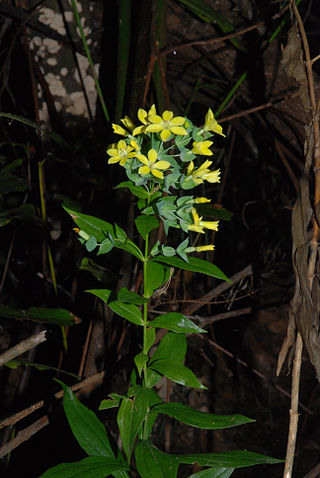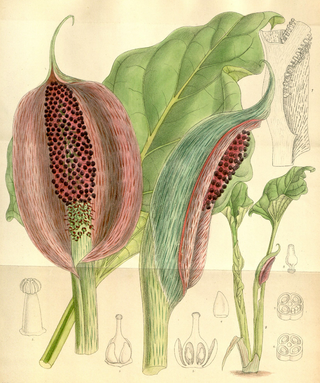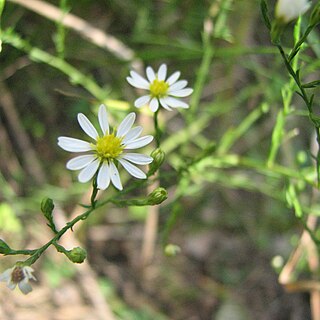
Plumeria, also known as frangipani, is a genus of flowering plants in the subfamily Rauvolfioideae, of the family Apocynaceae. Most species are deciduous shrubs or small trees. The species are native to the Neotropical realm, but are often grown as cosmopolitan ornamentals in tropical regions, especially in Hawaii, as well as hot desert climates in the Arabian Peninsula with proper irrigation.

Serpentine soil is an uncommon soil type produced by weathered ultramafic rock such as peridotite and its metamorphic derivatives such as serpentinite. More precisely, serpentine soil contains minerals of the serpentine subgroup, especially antigorite, lizardite, and chrysotile or white asbestos, all of which are commonly found in ultramafic rocks. The term "serpentine" is commonly used to refer to both the soil type and the mineral group which forms its parent materials.

Erica tetralix, the cross-leaved heath, is a species of flowering plant in the family Ericaceae, native to western Europe.

Pimenta is a genus of flowering plants in the myrtle family, Myrtaceae described as a genus in 1821. It is native to Central and South America, Mexico, and the West Indies.

Streptanthus glandulosus subsp. niger is an endangered subspecies of flowering plant within the family Brassicaceae. Like other genus members, this herb has wavy petal margins with perimeter calluses that discourage larval herbivory. This plant is endemic to the Tiburon Peninsula of Northern California, and occurs at elevations below 150 m on serpentine grasslands. The common name for this subspecies is Tiburon jewelflower or black jewelflower. This annual herb blooms in May and June and displays dark purple sepals. The etymology of this genus scientific name derives from the Greek word streptanthus, meaning twisted flower, with reference to the notable wavy margins of the petals. The subspecies name niger relates to the color of the seeds being black, although an alternate account cites the dark color of the petals as the source of the appellation.
Carpodiptera is a genus of flowering plants in the family Malvaceae.
Athyana is a monospecific genus of plant in the family Sapindaceae, containing only Athyana weinmannifolia. It is found in Argentina and Bolivia. It is threatened by habitat loss.
Reynosia is a genus of plant in family Rhamnaceae. Darlingplum is a common name for this genus.
Tabernaemontana wullschlaegelii is a species of flowering plant in the family Apocynaceae. It is endemic to Jamaica.
Diacidia is a genus in the family Malpighiaceae. It comprises 11 species of trees, shrubs, and subshrubs. Ten species are found on the mountains of southern Venezuela and adjacent Brazil; one species is widespread in the drainages of the Rio Negro and the Río Vaupés in Venezuela, Colombia, and Brazil.
Glandonia is a genus of flowering plant in the family Malpighiaceae. It comprises 3 species of trees or shrubs native to lowland forests along rivers or in areas periodically flooded in Amazonian Colombia, Venezuela, and Brazil.
Blepharandra is a genus in the family Malpighiaceae. It comprises 6 species of trees and shrubs native to sandy savannas and scrub forests of Guyana, southern Venezuela, and Amazonian Brazil.

Ixanthus is a monotypic plant genus in the family Gentianaceae. The sole species, Ixanthus viscosus, is endemic to Canary Islands laurel fields and displays small yellow flowers when in bloom.

Synandrospadix is a monotypic genus of flowering plants in the family Araceae. It comprises a single species Synandrospadix vermitoxicus. It is found in Peru, Argentina, Paraguay, and Bolivia. The inflorescence has an unpleasant smell with a spathe whose inner surface is purple with brownish-green warts and a smooth green outer surface. The spadix is egg shaped, red, and has spiked male flowers protruding from it.

Symphyotrichum depauperatum, commonly known as serpentine aster or starved aster, is a rare species in the family Asteraceae adapted to serpentine barrens, an ecosystem with a high concentration of toxic metals in the soil. It has been found in Pennsylvania, Maryland, and on some diabase glades in North Carolina. It grows to 50 centimeters and has white ray florets surrounding a center of yellow disk florets.

Phacelia dalesiana is a species of flowering plants in the borage family endemic to California. It is commonly known as Scott Mountain phacelia or Howell's phacelia. Under the synonym Howellanthus dalesianus, it was considered to be the only species in the monotypic genus Howellanthus.
Dicella is a genus of flowering plant in the familyMalpighiaceae. It includes seven species, assigned to two sections. Section Dicella comprises D. bracteosa and D. nucifera, found in southeastern Brazil and adjacent Paraguay and Argentina. Section Macropterys includes D. aciculifera, known only from Costa Rica, and D. conwayi, D. julianii, D. macroptera, and D. oliveirae, all of South America from Colombia south to about 19°S
Haenianthusis a genus of flowering plant in the family Oleaceae. It is native to the Greater Antilles of the Caribbean. It contains 3 species:
- Haenianthus incrassatus(Sw.) Griseb. - Jamaica
- Haenianthus salicifoliusGriseb. - Cuba, Hispaniola, Puerto Rico
- Haenianthus variifoliusUrb. - Cuba

Rhynchocorys is a small genus of flowering plants belonging to the family Orobanchaceae. It was formerly classified in the family Scrophulariaceae.
Mionandra is a genus of flowering plants belonging to the family Malpighiaceae.









